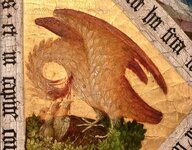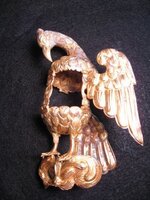RELICDUDE07
Bronze Member
When i first saw it, i thought it may have been some type of hanging bedside candle holder -close the shutters to dim the light .What ever it was ----- it's a true TREASURE!!!!!!!Im so glad you found this piece of history!
Follow along with the video below to see how to install our site as a web app on your home screen.
Note: This feature may not be available in some browsers.
A Pelican in Piety. Great ID by Dr. Eugene Lyon.Jeff K said:


bigcypresshunter said:I doubt that I can be of much help but I would like to ask a few questions. This is indeed an incredible find, Bonnie, and a mystery.
Did you say it has 3 eyelets- one on the head and one on each wing?
It also appears to have 3 holes dead center in the hinges. The holes must serve a purpose.They must be there for a reason.
Anything on the base, hole or eyelet? Will it stand up on its own?
Do the wings move with the hinge? Do you see any wear marks?


capthawk said:the "pelican in piety" looks to be our bird - a PELICAN!! Many thanks to Gene Lyons for the id. Brent Brisben ( I am subcontracting for his company) came aboard and told me and with the engine running and the diving I thought "no way" - that's no pelican. But guess I haven't seen too many gold birds around the docks..
 I guess its portraying one of the Egyptian Pelicans.
I guess its portraying one of the Egyptian Pelicans. 
At first I thought about the wine chalice too but because it looks as if it would be hard to drink from, Im sticking with my guess that it was to dispense Holy Communion (bread wafers).Darren in NC said:I believe Laura is most accurate when referring to the Eucharist. Since the pelican symbolizes the sacrificial blood of Christ, I believe it specifically refers to the cup (or wine) of Holy Communion more than the bread . I've noticed that the pelican is found on chalice coverings - see upper right photo. The top middle photo is a baby pelican drinking from the chalice.
I wonder if this bird Bonnie found was an altar piece for holding wine?
As far as the look of this pelican, medieval renderings of the pelican look like chicken, geese or eagles. But church history is clear that it is a pelican.
bigcypresshunter said:At first I thought about the wine chalice too but because it looks as if it would be hard to drink from...
Its been I while since I been to church, but when I went to my Moms funeral service, the priest handed me a solid gold chalice full of wine. My sister had to bump me and tell me to just take a sip lol.Darren in NC said:bigcypresshunter said:At first I thought about the wine chalice too but because it looks as if it would be hard to drink from...
Of course you wouldn't drink from it, but it is a common practice to this day to dip bread in the cup. I'm not sure when wafers came onto the scene.
Fun brainstorming.
 ... the experts will tell us.
... the experts will tell us. 

elle said:The pyx found was not likely used as part of the chaplain's ornament set to give mass onboard.
Long ago, the use of a dove or a pelican as a pyx to hold the Eucharist, says with belief, that the bread is Jesus Christ.
